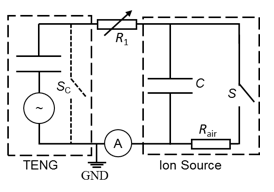Anyin Li, Facundo Martin Fernandez, Zhong Lin Wang, and Yunlong Zi from the Schools of Materials Science and Engineering, and Chemistry and Biochemistry at Georgia Tech have demonstrated a novel approach to quantitatively control the number of ions generated for mass spectrometry using triboelectric nanogenerator (TENG) output. The high output voltage of TENGs is ideal to induce both nanoelectrospray ionization (nanoESI) and plasma discharge ionization with the flexibility of generating controlled single polarity or alternating polarity ion pulses ranging from 1.0 to 5.5 nC with an onset charge of 1.0 nC. Spray pulse duration is adjustable on demand between 60 ms and 5.5. s. This invention achieves high MS analysis sensitivity (~0.6 zeptomole) with minimum sample consumption, native protein conformation conservation, and patterned ion deposition onto both conductive and insulating surfaces.
- Superior control over ionization process in duration, frequency, and polarity
- High MS sensitivity with minimal sample consumption and native protein conformation conservation
- Patterned ion deposition onto both conductive and insulating surfaces
- Eliminates high current hazards and cost
This TENG-drive ion generation opens up the possibility of charge-resolved MS analysis and ion utilization. Both nanoESI and plasma discharge ionization offer unprecedented control over ion generation in duration, frequency, and polarity via TENG actuation on demand with minimum sample consumption. The high voltage (5-9 kv) of TENG provided nanoESI with enhanced sensitivity at low concentrations, while the small number of charges in each pulse maximises sample utilization. A wide range of chemical compounds from small organic molecules (such as explosives and chemical warfare simulants) to large biomolecules can be successfully investigated usng TENG MS. Potential commercial applications include MS analysis, ion deposition, and microarray fabrication.
Due to its high sensitivity and unsurpassed molecular specificity, mass spectrometry (MS) is a key analytical tool with a wide variety of applications including biomedicine, food science, homeland security, systems biology, and drug discovery. The voltage applied to the ion source is a benchmark parameter for the process converting neutrals into gas-phase ions prior to mass analysis. However, the the number of ions generated is independent of the applied voltage. As a result, since ion sources for MS are usually driven by direct current (DC) power supplies, there is no user control over the total number of charges generated. This results in a large portion of the ions being wasted due to the pulsed nature of ion trapping, time-of-flight (TOF), and ion mobility (IM)-MS during experiments. These complications significantly affect sample utilization efficiency, detection limits, quantitative performance, and duty cycle. Conventional use of high voltage power supplies is also costly, has limited portability, and induces a number of safety concerns.

